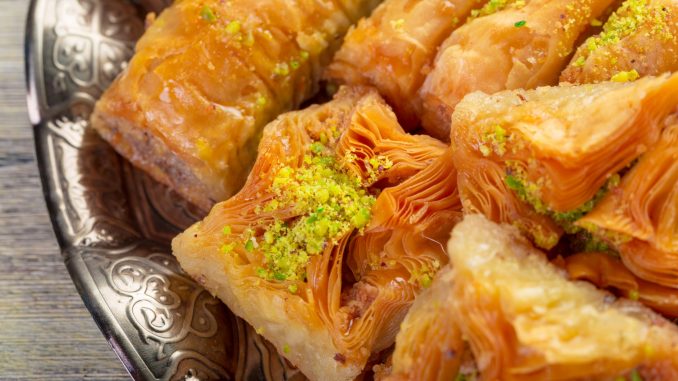
The rich and diverse culinary tapestry of Arabic countries extends beyond savory delights to a realm of exquisite sweetness. From the bustling markets of Cairo to the opulent dining tables of Dubai, Arabic sweets have long held a cherished place in the hearts and palates of locals and visitors alike. In Arabic language, sweets are called ‘Helo’ whilst the plural is ‘Halawyat’. Those described in this article are offered at parties, on special occasions and religious ceremonies. Our confectionery journey unfolds a narrative of tradition, culture, and craftsmanship, where each sweet tells a story of centuries-old recipes passed down through generations.
Baklava: A Multilayered Masterpiece
Among the crown jewels of Arabic desserts, baklava reigns supreme. It is also known as baglawa. This sweet, with its origins tracing back to the Ottoman Empire, is a finely layered pastry made of thin sheets of filo pastry dough, generously interspersed with chopped nuts, usually pistachios or walnuts, and bound together by a sweet syrup or honey. The result is a crunchy, sweet, and nutty marvel that showcases the mastery of pastry craftsmanship.
Kunafa: The Golden Delight
Kunafa, another iconic dessert, is a golden-hued pastry that captivates both the eyes and the taste buds. It typically features thin noodle-like pastry threads layered with rich, sweetened cheese or semolina and baked to a crispy perfection. The finishing touch involves drenching the pastry in a fragrant sugar syrup, creating a harmonious balance between sweetness and texture. Variations abound, with some regions favoring a cream-filled version or topping it with a dusting of crushed pistachios.
Qatayef: The Ramadan Staple
During the holy month of Ramadan, Qatayef takes center stage as a symbolic and beloved treat. These half-moon shaped dumplings are filled with a variety of delights, such as sweet cheese, nuts, or a delectable mixture of cinnamon and sugar. Often fried or baked, Qatayef are then drizzled with rose or orange blossom water for an aromatic touch, making them an essential part of the festive Ramadan table.
Basbousa: A Semolina Symphony
Hailing from the Levant region, Basbousa is a moist and dense semolina cake, enriched with yogurt and sweetened with a generous dose of sugar or honey. What sets Basbousa apart is its distinctive texture, achieved through soaking the baked cake in a fragrant sugar syrup. This not only infuses the dessert with sweetness but also imparts a luscious moistness that elevates Basbousa to a dessert of distinction.
Ma’amoul: The Art of Stuffed Cookies
Ma’amoul exemplifies the artistry of Arabic pastry-making. These delicate, shortbread-like cookies encase a variety of fillings, including dates, nuts, or figs. Molded into intricate shapes using wooden molds, Ma’amoul are not only a culinary delight but also a visual feast. Often enjoyed during festive occasions, these stuffed cookies showcase the meticulous attention to detail that is a hallmark of Middle Eastern sweet craftsmanship.
Halva: The Sweet Sesame Confection
Halva, a confection enjoyed across the Middle East, has many variations but is typically made from ground sesame seeds or tahini, sweetened with sugar or honey. The result is a crumbly yet dense sweet treat with a nutty undertone. Halva is often embellished with nuts, dried fruits, or aromatic spices such as cardamom. It’s not only a dessert but also a popular energy-boosting snack, highlighting its versatility in Middle Eastern cuisine.
Atayef: The Stuffed Pancake Pouches
Atayef, akin to small stuffed pancakes, are a versatile delicacy found in various Arabic countries. These fluffy pouches are filled with a myriad of delightful fillings, such as sweet cheese, nuts, or sweetened cream. Depending on the region, Atayef can be baked or fried and are often served with a drizzle of sugar syrup or a dusting of powdered sugar. Their versatility makes them suitable for both sweet and savory occasions.
Samsamia
Sesame is the based for this sweet. The sesame is roasted to a gorgeous golden honey brown. Any sugar and honey is caramalised by heating it with ginger and often cinnammon. This caramalized sugar is folded in with the sesame and then rolled into thin sheets. The sheets are then cut into small but delicious squares.
Znoud El-Sit: The Lady’s Arms
The evocatively named Znoud El-Sit, or “Lady’s Arms,” are slender rolls of phyllo dough filled with sweetened cream or custard. These delicate pastries are fried or baked to golden perfection and then lavishly coated with sugar syrup. Znoud El-Sit exemplifies the delicate balance of textures and flavors that characterize Arabic sweets—crispy on the outside, creamy on the inside, and generously sweetened to create a dessert that is as pleasing to the eyes as it is to the palate.
A Sweet Tapestry of Tradition and Innovation
Arabic sweets are not just desserts; they are a cultural expression, a testament to the rich history and diversity of the Middle East. Whether it’s the multilayered elegance of Baklava, the golden allure of Kunafa, or the stuffed intricacy of Ma’amoul, each sweet tells a story of tradition, family, and celebration. As these desserts continue to captivate global audiences, they serve as ambassadors of a culinary heritage that seamlessly weaves together the past and the present, inviting everyone to savor the sweet symphony of the Middle East.
Leave a Reply